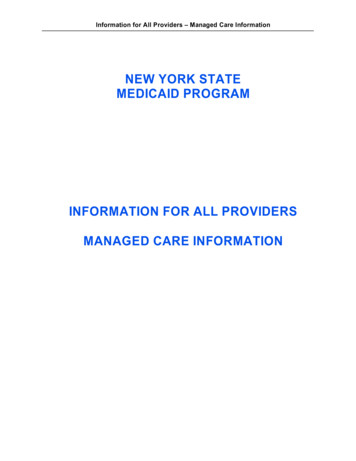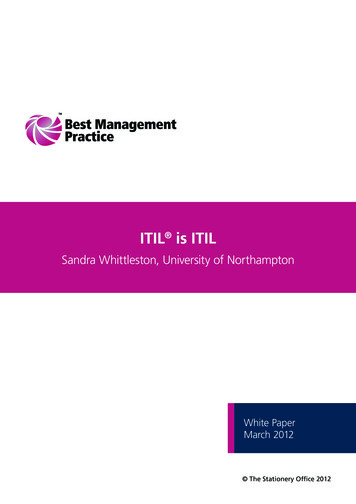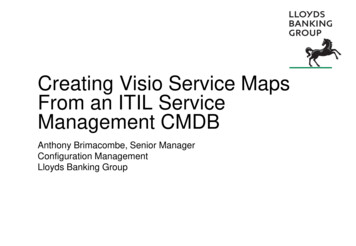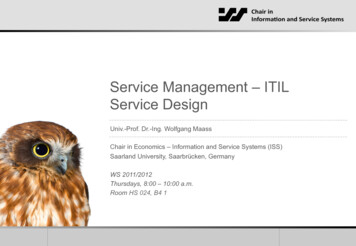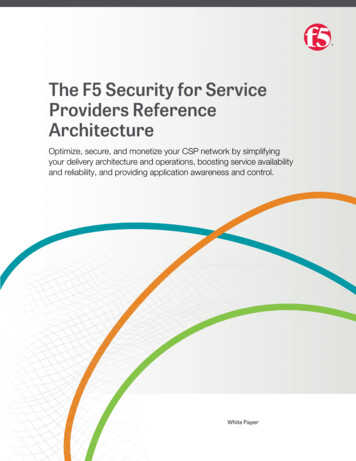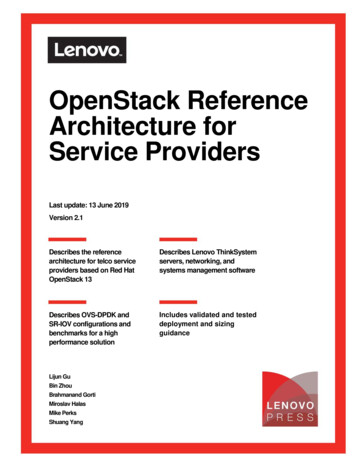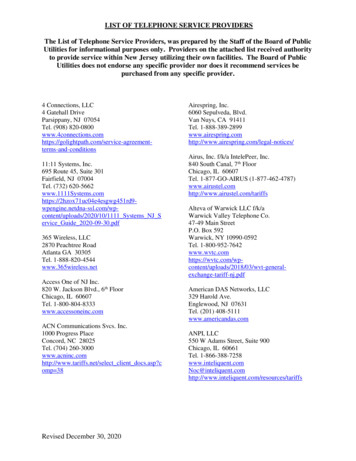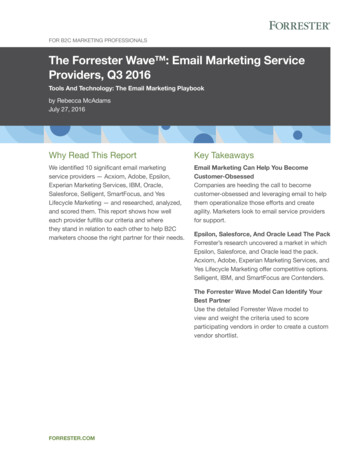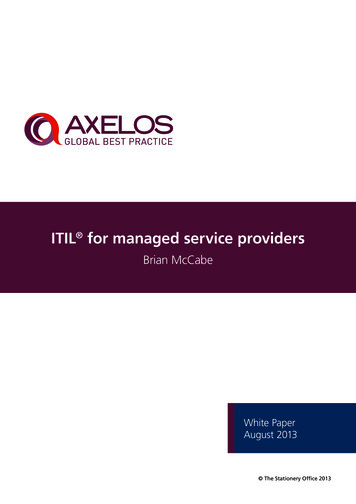
Transcription
ITIL for managed service providersBrian McCabeWhite PaperAugust 2013 The Stationery Office 2013
2ITIL for managed service providersContentsSynopsis31Managed service providers and ITIL32Service strategy63Service design84Service transition95Service operation126Continual service improvement147Summary15References16About the author16Reviewers16Acknowledgements16Trade marks and statements16 The Stationery Office 2013
ITIL for managed service providersSynopsisThis White Paper provides a practical review of real-worldchallenges, ideas and techniques to help managed serviceproviders deliver services aligned with ITIL . The paper focuseson the core ITIL lifecycle stages and how all stakeholders canmaximize the business benefits of adopting a structured servicegovernance approach.Many managed service providers use ITIL as a marketing badgeof industry compliance or, in some cases, claim to be formallyITIL-accredited, which is simply not possible (only individualscan be accredited – organizations as a whole cannot). Mostservice providers rarely realize the true benefits of introducingbest practice in a pragmatic, commercially sensible and clientfocused manner. Others adopt a highly mechanistic approach,following the five core ITIL publications (Cabinet Office, 2011) tothe letter and – in the process – alienating and restricting theirclients who may not be totally on board with the finer detail ofthese books.This White Paper will aid service providers in realizing thosebusiness benefits by encouraging them to follow the underlyingethos of ITIL to ‘adopt and adapt’ the principles, thus addingvalue to their clients’, and their own, business operations.The intended audience of this White Paper is primarily product/service design specialists and senior operational managementwithin managed service provider organizations. The paperwill also be of interest to prospective purchasers of thoseservices who wish to be informed of the challenges faced bythe managed service provider and to understand how best tomaximize the value to their own business of engaging in such athird-party relationship.Topics covered include: Constructing service offerings that are commercially viable,deliverable and add value to the receiving client organization The blending of the managed service provider’s servicedelivery approach with that of the client – and potentiallyother concurrent service providers – while maintaining aconsistent and effective set of processes, functions and tools The various staff resourcing models (dedicated, shared,on-site, remote, onshore/offshore/near-shore) adopted bymanaged service providers Service level management and the risk of poorly consideredservice level agreement (SLA) or operational level agreement(OLA) targets being achieved at the expense of clientsatisfaction and long-term service relationships Aligning inter-company SLAs with the client’s businessrequirements The impact of cloud computing on traditional IT servicedelivery and how managed service providers must adapttheir service delivery approach to stay relevant andcompetitive in the ‘everything-as-a-service’ world3 Ensuring financial controls are in place to protect themanaged service provider while still delivering true businessvalue to the client Driving continual service improvement in a commerciallyconstrained environment, such that all parties are ‘winners’.This White Paper looks at the governance considerationsinvolved in planning for the deployment of the core ITILdisciplines across the managed service provider organization,and also the specific management considerations that can beinvolved in individual client engagements.The distinction between management and governance is oftenoverlooked. In ITIL terms, management deals with makingdecisions and executing processes, whereas governance dealsonly with making sound decisions.Looking at ITIL and its adoption from the perspective of themanaged service provider, this White Paper addresses eachof the challenges head-on, clarifying some of the myths andmisconceptions regarding best practice. It contends that ITIL canbe deployed by managed service providers of all types and sizes,and within most budgets.1Managed service providersand ITILPrior to Version 3 (the 2007 edition of ITIL published by theOffice of Government Commerce), ITIL was primarily designedfor internally delivered IT services, providing guidance for theinternal help desk and associated support functions.Following the ITIL Refresh, ITIL V3 became far more relevantto external service providers, acknowledging the plethora ofsourcing approaches available to the modern-day IT executive.ITIL Service Strategy (Cabinet Office, 2011) provides high-levelviews of IT sourcing approaches, as described in Table 1.As can be seen from the standard ITIL definitions in Table 1,managed service providers come in many shapes and sizes,and it is near impossible to provide a one-size-fits-alldelivery approach to encompass this breadth of offerings.Fortunately, ITIL’s ethos of ‘adopt and adapt’, coupled withits modular nature, provides an ideal baseline from whichany managed service provider can construct its own servicegovernance model.Full ITIL roll-outs have typically been the domain of the largersystems integrators, but this does not need to be the case, andmany small-to-medium-sized service providers are currentlymissing out on the benefit of this proven best practice.This White Paper aims to dispel many of the myths that arefrequently used to justify the reluctance to adopt ITIL, andprovides guidance and encouragement for those who areunsure whether ITIL is appropriate for their business. The Stationery Office 2013
4ITIL for managed service providersTable 1 Main sourcing structures (delivery strategies)Copyright AXELOS Limited. Reproduced under licence from AXELOS Limited – ITIL Service Strategy, Table 3.20Sourcing structureDescriptionInsourcingThis approach relies on utilizing internal organizational resources in the design, development, transition,maintenance, operation and/or support of new, changed or revised services.OutsourcingThis approach utilizes the resources of an external organization or organizations in a formal arrangementto provide a well-defined portion of a service’s design, development, maintenance, operations and/orsupport. This includes the consumption of services from application service providers (ASPs) describedbelow.Co-sourcing ormulti-sourcingOften a combination of insourcing and outsourcing, using a number of organizations working togetherto co-source key elements within the lifecycle. This generally involves using a number of externalorganizations working together to design, develop, transition, maintain, operate and/or support a portionof a service.PartnershipFormal arrangements between two or more organizations to work together to design, develop,transition, maintain, operate and/or support IT service(s). The focus here tends to be on strategicpartnerships that leverage critical expertise or market opportunities.Business processoutsourcing (BPO)The increasing trend of relocating entire business functions using formal arrangements betweenorganizations where one organization provides and manages the other organization’s entire businessprocess(es) or function(s) in a low-cost location. Common examples are accounting, payroll and callcentre operations.Application serviceprovisionInvolves formal arrangements with an application service provider (ASP) organization that will provideshared computer-based services to customer organizations over a network from the service provider’spremises. Applications offered in this way are also sometimes referred to as on-demand software/applications. Through ASPs, the complexities and costs of such shared software can be reduced andprovided to organizations that could otherwise not justify the investment.Knowledge processoutsourcing (KPO)KPO is a step ahead of BPO in one respect. KPO organizations provide domain-based processes andbusiness expertise rather than just process expertise. In other words the organization is not only requiredto execute a process, but also to make certain low-level decisions based on knowledge of local conditionsor industry-specific information. One example is the outsourcing of credit risk assessment, where theoutsourcing organization has historical information that they have analysed to create knowledge which inturn enables them to provide a service. For every credit card company to collect and analyse this data forthemselves would not be as cost-effective as using KPO.‘Cloud’Cloud service providers offer specific pre-defined services, usually on demand. Services are usuallystandard, but can be customized to a specific organization if there is enough demand for the service.Cloud services can be offered internally, but generally refer to outsourced service provision.Multi-vendor sourcingThis type of sourcing involves sourcing different sources from different vendors, often representingdifferent sourcing options from the above. The Stationery Office 2013
ITIL for managed service providersITIL has also been traditionally viewed as being moreappropriate to IT infrastructure and telecommunications ratherthan software applications management providers. Again, this isa myth – ITIL is relevant to all aspects of IT service delivery.Managed service providers generally fall into the following highlevel categories: Application management outsourcers (AMOs) AMOsmanage off-the-shelf and custom software applications. Thiscategory includes application service providers as describedin Table 1, but it is broader in definition. AMOs can alsomanage applications that reside on client’s premises or inthird-party data centres; such applications include off-theshelf and custom developed solutions. Information technology outsourcers (ITOs) ITOsmanage desktops, servers, networks, printers and othersupporting infrastructure.Niche providers may deliver only one of the above servicetypes, whereas larger managed service providers will offerboth – either directly or through the use of partners. The term‘outsourcing’ is used in its most generic form above and refersto any external service provider. Clearly the overall serviceportfolio will vary greatly between managed service providers,where the focus may be on specific technologies, deliverymethods or particular market sectors.In many cases, the managed service provider will itselfsub-contract services to a third-party supplier as part of anaggregated service delivery model, or partner with other serviceproviders in a consortium. ITIL, when deployed effectively,provides a highly efficient framework for such multi-faceted,multi-sourced environments.Service providers can significantly broaden their serviceportfolios by adopting a robust service governance model as acatalyst to partake in multi-sourced arrangements. In expandingits portfolio the managed service provider also expands thesize of the available market for its services. Even in cases wherethe managed service provider has limited appetite to partneror sub-contract services, an effective service managementapproach will reduce process inefficiencies and generateopportunity for growth. As a commercial enterprise, these areclearly attractive propositions.A study by Gartner (2009) showed that just over half of thesurveyed companies selected a single managed service providerfor both infrastructure and applications. Managed serviceproviders who are able to provide a greater breadth of services– either directly or through effective partnership with otherservice providers – will have access to a far broader share of theavailable market than those who do not.By adopting ITIL, the service providers will also communicateusing a common language and have more compatible coreprocesses than those who adopt a purely home-grownapproach to service management. From a client’s perspective– and also that of other service providers who may be working5as part of a partnership – ITIL adoption builds confidence andreduces any potential resistance to engage with the managedservice provider. The time taken to transition services is reduceddue to the use of a common language; ongoing communicationand collaboration are also far less ambiguous.From a personnel resourcing perspective, managed serviceproviders deliver service using a range of models, including: Dedicated resources Where one or more namedindividuals are dedicated to work on a single clientengagement. Such engagements result in a close affinitybetween the managed service provider’s resources and theclient’s IT systems. Depending upon the ratio of client staffto managed service provider staff, this can often result in oneof the following situations:–– Where the client staff outnumber the managed serviceprovider staff, the managed service provider augmentsthe client’s own team while adopting the client’sprocesses, tools and methodology. In such cases themanaged service provider may feel that it is restricted inits ability to influence improvement and standardization ofapproach, with managed service provider personnelpotentially ‘going native’ within the client organization–– Where the managed service provider staff outnumber theclient staff, the managed service provider has greaterinfluence over the introduction of its own standardprocesses, thus driving a level of consistency for its ownservices but at the risk of isolating that provider from therest of the client organization unless the integration of thetwo approaches is relatively seamless. Shared resources Where the managed service provider’sstaff can work on multiple clients in parallel, thus passing onthe commercial economies of scale and breadth ofexperience to the client in the form of reduced costs andpotentially broader technological experience. Themethodology challenge for the managed service provider inthis model is to construct an approach that is familiar to itsown staff, regardless of which client they are working with,while not forcing the client into a totally unfamiliar way ofworking. ITIL provides the flexibility required to strike thisbalance but will require some creative thinking at times toarrive at a ‘mix and match’ portfolio of service processes,functions and tools. Blended resources Where a single contract is fulfilled by acombination of dedicated and shared resources, often in aflexible model, where the headcount can go up or downbased on client demand. This combination clearly carries thepros and cons of both the dedicated and shared resourcingmodels and, if not managed correctly, can lead to confusionwithin the service provider’s own teams regardless of howthe client operates.In the dedicated model, the resources may be physically locatedat the client’s premises or they may be located remotely, as isusually the case with the shared model (see Figure 1). Somemanaged service providers (for example, break-fix hardware The Stationery Office 2013
6ITIL for managed service providersengineers) will deliver mobile services, visiting the client locationonly when required. These can also be delivered using either adedicated or shared approach.move to cloud delivery of commodity services begins to drive aconvergence of application management and business processmanagement.The remainder of this White Paper will focus on several of thekey discussion points that impact on the adoption and positivecontribution of ITIL within the external managed servicessector. These topics will be covered under the framework ofthe ITIL service lifecycle stages, and in the form of responsesto commonly held misconceptions regarding such serviceadoption, accompanied by some critical success factors specificto managed service providers.2Figure 1 Resourcing matrix for managed serviceprovidersThe challenge of building a robust service managementapproach that works in harmony with client operations isfurther complicated in multi-sourced engagements. Commonsense dictates that having a common language can vastlysimplify the creation of a coherent, multi-party servicegovernance model. That common language is provided withinthe ITIL framework.Service strategyService strategy for managed service providers is primarily acommercially focused exercise in determining the businesscase for both the managed service provider and its prospectivecustomer(s). Figure 2 provides a summary of the service strategystage of the lifecycle. Depending upon the target customerprofile and engagement size, the managed service providermay define a strategy around a single large account or, moreusually, create a portfolio of standard service offerings that canbe tailored (typically during service design) to fit with individualcustomer needs.Key considerations for managed service providers are: Which services to take to marketAdditional challenges can arise for managed service providerswhen their organization provides a mixture of offerings to thesame client base – for example, consulting or project-basedservices – alongside ongoing managed services. The interplaybetween project- and service-based delivery can be a significanthurdle to service quality and client perception if not addressedcorrectly. Section 4 relating to service transition focuses onthese challenges. How to structure those servicesThe sourcing and delivery strategies mentioned above donot apply solely to IT services. Business process outsourcing(BPO) can also deliver value to end-user organizations by subcontracting specific – typically back-office – processes to athird party. Those services are outside the scope of this WhitePaper but we would expect the lines between ITOs, AMOs andBPO to become even more blurred as time progresses and the How to charge clients, and what approach to adopt to arriveat such pricing (for example, value-based or cost-plus) whilestill demonstrating a tangible return on investment for theclient The delivery methodology (staff resourcing approach, on-siteversus remote etc.) What type of organization will buy the service, and why The market appetite for such services, the size of the targetsector, and the expected market penetration rate How much the service will cost to deliver What charging model(s) to offer – for example, pay-per-use,fixed price, time and materials, shared risk/reward model?Figure 2 Lifecycle summary – service strategy The Stationery Office 2013
ITIL for managed service providers7 How to ultimately drive business value for the managedservice provider’s organization and for the client business;and how to measure and report this value.is a wealth of public domain knowledge and advice available,backed by an ever-maturing and affordable set of tools to assistthe managed service provider on this journey.Many managed service providers will launch services withoutconsidering all of these aspects, often resulting in a substandard and/or failed service offering. The service strategyprocesses ensure that the managed service provider thoroughlyqualifies a service offering before committing preciousmarketing and service development funds to the initiative.‘Cloud computing signals the end of ITIL for service providers’Some popular misconceptionsThat said, The Stationery Office – the publisher of the fivecore ITIL publications – recognizes this and regularly producescomplementary materials to ensure that the content remainscurrent. Additionally, the core publications are structured insuch a way that they will continue to be highly relevant to abroad array of existing and emerging technologies.‘The IT services my company delivers will not work with ITIL.’All IT service delivery models can benefit from ITIL-alignedservice governance. ITIL’s philosophy of ‘adopt and adapt’provides a flexible framework of best-practice guidance whichthe managed service provider can tailor to fit with its ownoperations, introducing ITIL in a phased and pragmatic manner.This is true whether the managed se
This White Paper provides a practical review of real-world challenges, ideas and techniques to help managed service providers deliver services aligned with ITIL . The paper focuses on the core ITIL lifecycle stages and how all stakeholders can maximize the business benef

